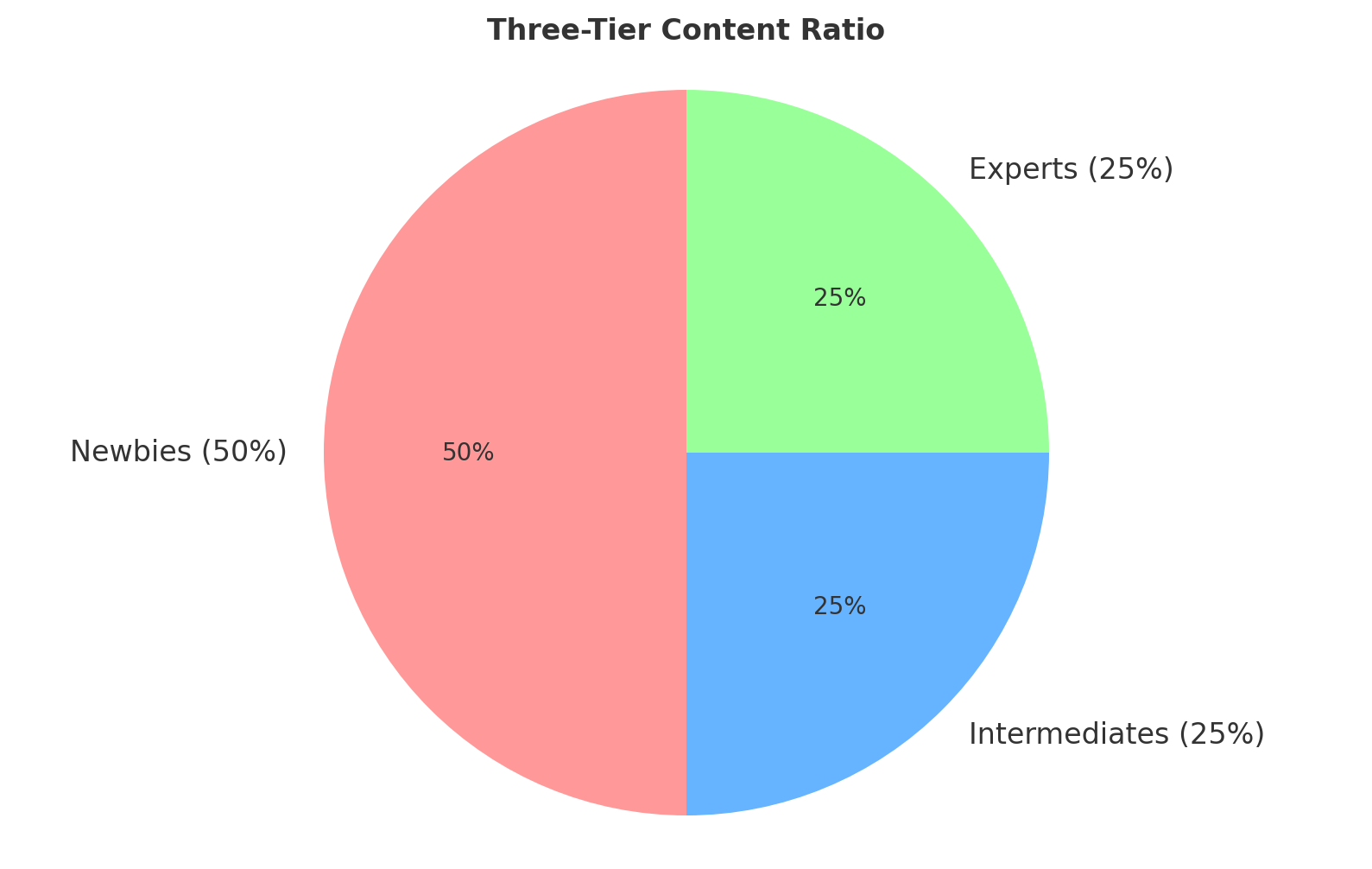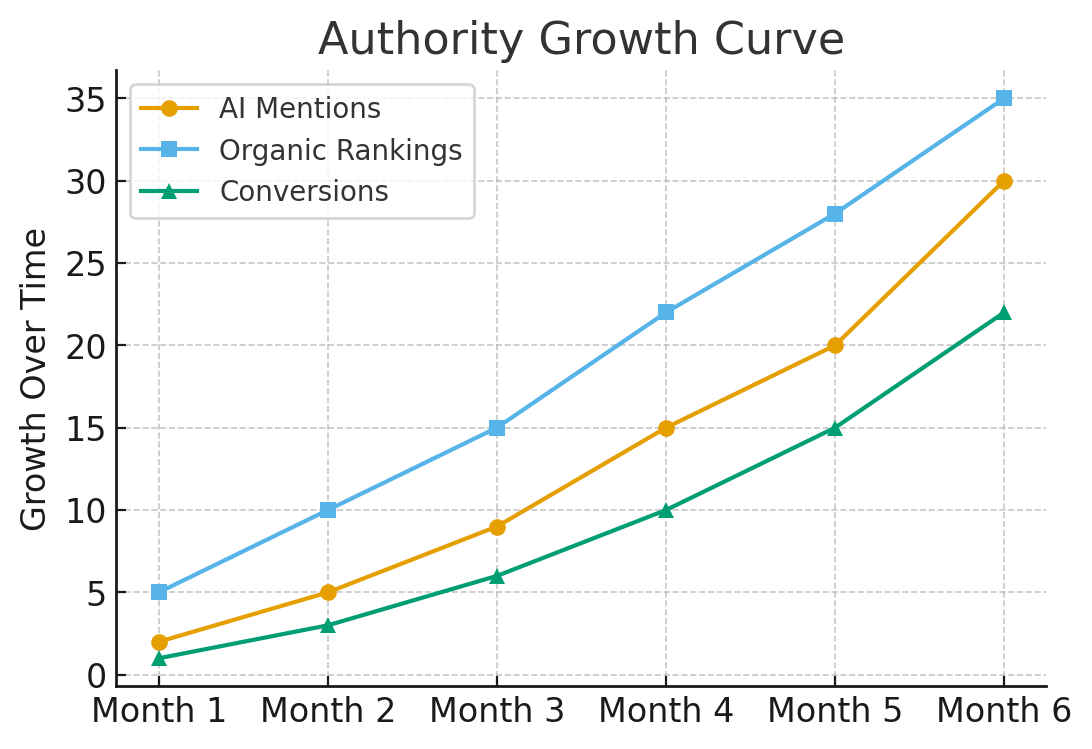Showing up in both traditional search and AI search isn’t just about traffic. It’s about trust. When you’re there, people believe you. They see your brand as the authority.
This three-tier blogging strategy is built for both kinds of clients we serve. The Hyperfocused ones in enterprise and e-commerce, reaching wide markets with products and services. And the Hyperlocal ones, carving out smaller but highly specific markets like basement waterproofing, pest control, or home inspections.
When your content is the answer that AI Overviews, ChatGPT, or Perplexity chooses to highlight, you’re not just visible — you’re validated. The system itself is telling readers that you’re the one worth listening to.
That kind of exposure compounds. Humans trust you more. AI platforms cite you more. Before long, you’re not just part of the conversation — you’re the reference point.
The way there isn’t magic. It’s structure. Content that speaks to people at every stage of the funnel. Content that’s clear enough for readers and sharp enough for machines to extract, summarize, and spread.

Why a Three-Tier Blogging Strategy Works Across SEO and AI Search
Treat everyone the same, and you miss almost everyone.
Beginners aren’t ready for your deep dives. They’re looking for the basics like definitions, simple guides, and the first steps.
Intermediates? They’re past the basics. They want comparisons, proof, stories, and data that let them make smarter choices. And the experts, the smallest group, are ready to buy. They just need you to show them the exact solution that makes sense.
A three-tier blogging strategy speaks to each of them. It gives you presence at every stageL: the first curious glance, the moment of hesitation, and the final “yes.”
And here’s what’s great about this strategy. This is exactly how AI systems think about authority. These systems are not just looking for information. They’re weighing completeness. Does your content teach the beginner? Does it stretch the intermediate? Does it give the expert confidence to act?
When your blog does all three, AI engines have no choice but to treat you as the source. That’s how you get pulled into the answers people see, the summaries they trust, and the authority they believe.
The 50/25/25 Ratio and Its Role in Visibility
The smartest strategies don’t guess. They follow the shape of the funnel.
Half your content should speak to beginners. A quarter should guide the ones in the middle. The last quarter? That’s for the experts, the people who are already leaning forward, ready to act.
It works because this is how audiences actually show up. Most arrive at the top, curious but unprepared. Fewer make it halfway, weighing their options. And only a handful reach the bottom, but they’re the ones who matter most.
By spreading your effort this way, you capture attention at scale and still serve the high-value readers who are closest to a decision.
These visitors typically represent three levels:
- Newbies (at the top of the sales funnel) don’t know much about your product, services, industry or business.
- Intermediates (in the middle of the sales funnel) are educated but crave more knowledge.
- Experts (at the bottom of the sales funnel) are, well, experts and seek something new.
For example, here’s a dealership-specific rewrite of that framework, adapted to new/used motorcycle sales, parts, and apparel:
- 50% for riders who know little or nothing about motorcycles, including what to look for in a first bike, the difference between new vs. used, and how dealership support helps. This content educates beginners, lowers their entry barriers, and influences them to start their riding journey at the dealership.
- 25% for those who already ride and have some knowledge, but are actively searching for their next upgrade, exploring new models, or needing trusted parts and apparel. This content positions the dealership as the go-to resource for expertise, product availability, and financing options.
- 25% for experienced riders who already buy from dealerships but are looking for an edge, such as specialized service, hard-to-find parts, exclusive apparel lines, or premium trade-in opportunities. This content convinces them why this dealership stands out from competitors and keeps them loyal.
AI systems also value this balance. When a query enters an AI tool like ChatGPT, it often tries to provide both a simple explanation and an advanced breakdown. If your blog already covers that journey from beginner to expert, AI will be more likely to summarize your content. This balance of breadth and depth makes your posts highly adaptable for both traditional SEO and AI-driven visibility.
Tier 1: Engaging Newbies in SEO and AI Search
Beginners are the crowd at the door. The biggest group you’ll ever see.
They don’t need complexity. They need clarity. Give them definitions. Give them guides. Give them the simple “how it works” so they can step inside.
This content becomes your foundation. It’s the welcome mat. The starting point. The piece that pulls the most people into your world and invites them to stick around.
AI engines often feature beginner content in their results because it overlaps with the most common questions people ask. When users type or say things like ‘what are aftermarket parts’ or ‘how do I start a blog,’ AI systems want to provide quick, easy-to-digest answers. By creating pillar posts and skyscraper content that address these questions, your content becomes more likely to appear in AI Overviews and conversational answers.
Keyword targeting is especially important at this stage. Broad but long-tail terms like ‘Ducati Scrambler aftermarket parts’ work better than highly competitive terms like ‘Ducati parts.’ Not only do these keywords give you a better chance of ranking, they also match the way AI interprets beginner-level intent.
Adding FAQs at the end of beginner-focused posts increases your chance of being cited. AI tools often extract Q&A content directly into their results, so structuring your content this way helps both readers and search systems process it more effectively.
Tier 2: Influencing Intermediates in SEO and AI Search
Intermediates aren’t asking “what is it?” anymore. They already know.
Now they want proof. They want comparisons. They want stories that show what works and what doesn’t. They’re looking for the next step, and they’re deciding who to trust to take it with.
This is where detailed guides, case studies, and performance breakdowns shine. Give them substance, and they’ll give you attention.
These readers matter because they’re weighing their choices. And when your insights are the ones AI systems surface in a summary, your authority isn’t just implied — it’s stamped and certified.
Examples work well for intermediates. If you sell motorcycle parts, an intermediate-level blog might highlight a detailed breakdown of upgrades for a Ducati Panigale or provide a performance comparison between models. AI engines prefer this type of structured information because it contains context, detail, and clear value for decision-making.
Tier 3: Converting Experts in SEO and AI Search
Experts don’t need the basics. They’ve already done the homework.
They’re here for specifics. The edge cases. The niche solutions that seal the deal.
This group is small, but it’s gold. They’re ready to buy, and they just need confirmation. Give them the detailed insights, the technical answers, the precision they’re searching for, and you become the obvious choice.
Targeting long-tail, low-volume keywords is most effective here. Even though fewer people search for terms like ‘ECU flashing for Ducati V4 Panigale race setups,’ the ones who do are serious buyers. When AI surfaces your content for these very specific questions, it places your brand directly in front of an audience that is ready to convert.
At this stage, CTAs must be strong and direct. ROI calculators, consultations, or quote requests should be integrated naturally into the content. When AI highlights these pages, your CTAs provide the next clear step, which improves both conversions and brand authority.
 How Data and AI Search Optimization Build Authority
How Data and AI Search Optimization Build Authority
Data is the backbone of refining this strategy. Analytics show which content resonates, which audiences engage, and how conversions happen. Tracking how your posts appear in both traditional search and AI results gives you insight into where authority is forming and where gaps remain.
Updating content is just as critical. AI systems prioritize fresh information because users expect the most accurate answers. By revisiting your top-performing blogs and refreshing them with new statistics, updated examples, and improved CTAs, you maintain authority and ensure continued visibility.
Structured formatting also improves AI discoverability. Adding sections, lists, and conversational phrasing makes it easier for search systems to identify key points. This increases the chance of your content being summarized or quoted in AI-generated answers.
Creating a CTA Framework That Works in AI Search
A call to action isn’t one-size-fits-all.
Beginners want the low-stakes stuff like guides, checklists, something that feels safe. Intermediates want proof like webinars, case studies, deeper dives that show them the path forward. Experts? They’re ready. Give them consultations, pricing tools, the direct next step.
This tiered approach keeps the journey smooth. It makes sure that when AI surfaces your content, every reader sees the offer that fits exactly where they are.
That’s why the three-tier strategy works. It mirrors how people actually learn and decide. It matches what AI engines are trained to reward — clear, structured answers at every level. Cover all three tiers, and your blog stops being just another article. It becomes a system for authority. A tool that ranks, gets cited, and builds trust that compounds over time.
FAQs
How does a three-tier blogging strategy help with AI search visibility?
It provides structured answers for every level of knowledge, which AI engines use to build summaries. Covering beginners, intermediates, and experts makes your content more complete and therefore more likely to be cited.
What type of content do AI systems prefer to feature?
AI systems prefer content that is clear, structured, and conversational. Posts with lists, FAQs, and direct explanations are more likely to be pulled into AI results.
Why is it important to update older blogs for AI search?
AI systems prioritize fresh and accurate information. Updating older posts with new statistics and examples signals authority and improves visibility.
Can long-tail keywords really increase brand authority?
Yes, because long-tail keywords capture highly specific intent. Even with lower search volume, these terms attract serious readers and buyers, which strengthens both authority and conversion rates.
How do CTAs impact AI-driven visibility?
CTAs that align with the funnel provide clear next steps for readers. When AI cites your content, those CTAs become part of the pathway that drives conversions directly from AI-generated summaries.



